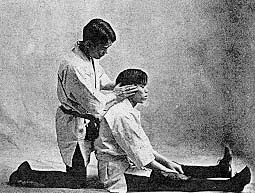
Injuries are part of the martial journey.
Acupuncture, herbal remedies, bone setting (sekkotsu) and resuscitation skills
(kappo) were areas of knowledge held by the old-time masters of combat. Through the investigation of physiology, martial artists not only had a better understanding of healing, but also how to disrupt certain areas through atemi (vital strikes). But skeptics question the authenticity of Eastern holistic ways, in particular Traditional Chinese Medicine (TCM). Indeed, the National Council Against Health Fraud (NCAHF) claims that of the 46 medical journals published by the Chinese Medical Association, not one is devoted to acupuncture or other TCM practices.
Still, while hurting people is relatively easy, it's healing that requires perhaps a higher calling, whether its through conventional medicine, alternative methods, or a combined approach as proposed by Andrew Weil who has authored several books on his "integrative medicine" theories. But it was Ben Franklin who probably had the best advice of all: "An ounce of prevention is worth a pound of cure."

No comments:
Post a Comment